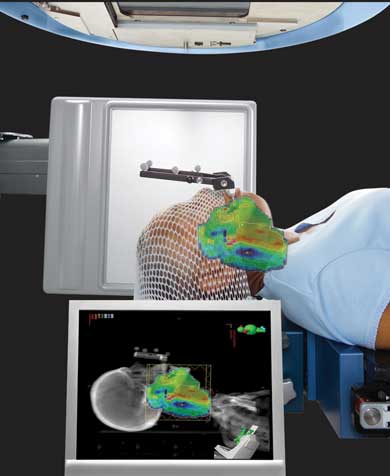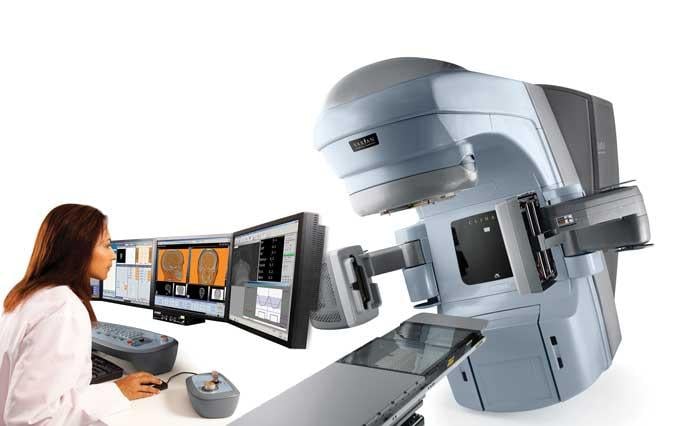
Clinac by Varian Medical Systems.
Since volumetric modulated arc therapy (VMAT) became available in the U.S., it has taken off in radiation oncology as fast as it treats and cures patients.
The promise of VMAT delivery is to drastically cut treatment times compared to traditional IMRT. The shorter treatment times result in less patient movement, and thus increased accuracy and the potential to spare healthy surrounding tissue.
The adoption of VMAT is driving an influx of new VMAT-enabled tools to market, and leading the trend are new treatment planning solutions with arc-enabled modules.
From IMRT to VMAT
Taking IMRT to a new level, Elekta and Varian Medical Systems developed the first commercially available solutions providing volumetric-arc therapy. Elekta grabbed the acronym — VMAT — to brand its treatment solution, while Varian introduced its arc therapy solution RapidArc.
Treatment planning for Elekta’s system follows a similar approach to planning for conventional IMRT, but Elekta’s VMAT can be delivered using a single arc, multiple arcs, partial arcs, or a combination, depending on what the physician considers best for the patient. New VMAT tools enable users to create arc-based treatment plans using the same features available in Elekta’s Monaco solution. With reduced planning time and increased clinical throughput, Monaco with VMAT optimizes single or multiple non-coplanar arcs simultaneously.
“It’s fair to say there is a lot of interest around volumetric arc therapy. It likely will be widely adopted,” said Vivek Mehta, M.D., radiation oncologist, Swedish Cancer Institute, Seattle, Wash. “There are two drivers. One is it’s a much more efficient way of treating patients, because it shortens the time the patient has to spend on the table, and it reduces the dose to normal tissue. That’s what’s going to drive uptake.”
Redesigning Treatment Plans
The rapid uptake of VMAT is the force behind the development of new treatment-planning solutions programmed to include algorithms for volumetric arc therapy planning.
This year Philips launched SmartArc, an independent treatment planning solution for volumetric-modulated arc therapy (VMAT). Bundled as a module in Philips’ Pinnacle3 version 9 radiation treatment planning (RTP) software, the new planning option can be used with any VMAT-capable delivery system on the market. The system provides for constant-dose rate delivery designed to allow clinicians to explore the benefits of VMAT delivery without the expense and downtime associated with an upgrade to their linear accelerator.
Dr. Mehta uses IMRT or VMAT to treat patients with brain, head and neck, intra-abdominal tumors, such as pancreas, gastric, for prostate cancers and to treat patients that have been previously irradiated. SmartArc allows single or multiple user-definable arcs and supports both constant- and variable- dose rate delivery. The advantage of both constant- and variable-dose rate delivery is it “allows for improved planning and dose delivery, particularly for patients with complicated target volumes,” explained Dr. Mehta.
“With conventional IMRT techniques, you can treat from a number of different angles, but the more angles you treat from the longer the patient is on the table. So it comes to a point of diminishing returns,” said Dr. Mehta. “So when you have this arc-based approach, which allows you not only to modulate the beam but also to modulate the energy, and time is no longer a factor because it’s so much quicker, you can actually create what you could have created before, but with volumetric arc you can actually reasonably implement it.” In Dr. Mehta’s experience of working with SmartArc, he said it has “increased throughput, improved plan quality and increased the concordance with QA results.”
As to whether optimizing the use of more angles results in less damage to the surrounding tissue, it is too early to tell. But what Dr. Mehta can say today is “when we do those plans, there is less dose to the surrounding normal tissues. Now whether that reduction of dose causes less damage, that’s going to take time to tell. Generally speaking less dose to normal tissues is a good thing. So, the tumor dose is maintained, but the normal tissue dose is reduced.”
Nucletron also recently released software customized for VMAT. Building on its Direct Step and Shoot (DSS) technology, the company has developed Oncentra VMAT, an independent solution for VMAT. Oncentra VMAT provides clinicians with next generation planning capability, including support for single-arc, dual-arc and skip-arc techniques for compatible Varian and Elekta accelerators.
VMAT Outpaces IMRT
Where VMAT outpaces IMRT is in delivering the complete IMRT treatment in fewer rotations than traditional IMRT. This reduces patient time on the table, and in theory, should lessen the risk of damage to surrounding critical structures.
Bethesda Memorial Hospital (BMH), Boynton Beach, Fla., initiated treatments with RapidArc on September 15, 2008. Since then, they have steadily increased the number of patients receiving RapidArc therapy.
“With RapidArc, we have seen a significant improvement in efficiency. While we continue to treat some patients with conventional IMRT, we are increasingly moving towards the use of RapidArc as a standard deliver technique whenever IMRT is prescribed, which for us is in about 40 percent of all cases. Our initial disease site was prostate, where we found we were able to reduce the patient’s total time in the treatment room by nearly 50 percent, including typically about 7-8 minutes for setup, image guidance and treatment delivery,” said Matt Skinner, chief medical physicist, department of radiation oncology, Bethesda Memorial Hospital.
In addition to shorter treatment times, BMH clinicians find that RapidArc treatment plans are often superior to plans for fixed-field IMRT, due to improved critical structure sparing along with excellent target dose homogeneity. “We have created both IMRT and RapidArc plans concurrently for many patients, to compare the modalities. More often than not we end up selecting the RapidArc plan for both the time savings and due to the superior plan quality.”
“In the view of our physicians, the isodose plans generated for RapidArc are superior to the majority of the IMRT plans for those cases,” said Skinner.
While it is soon to tell whether there is definitively less damage to the surrounding tissue due to RapidArc, Skinner did say, “When comparing the dose-volume histograms generated for IMRT plans and for RapidArc plans, in the large majority of cases, the RapidArc plan DVHs are superior for both the targets and critical structures.”
RapidArc has enabled BMH to expand treatments to non-conventional sites, meaning sites that were difficult to treat even with conventional IMRT, such as large meningiomas. Another unique technique that Rapidarc treatment planning has enabled is whole scalp treatment. “We have planned a whole scalp treatment with RapidArc, a treatment that would previously have required well over an hour of in-room time for the patient to setup multiple, matched electron fields,” Skinner explained.
RapidArc is also now being used to deliver stereotactic body radiotherapy (SBRT) and SRS (stereotactic radiosurgery) in the treatment of spine, kidney, liver, and adrenal gland metastatic lesions. “Our RapidArc SBRT plans typically utilize 2-3 arcs, as compared to the 11-13 static fields, which was the approach we previously used. RapidArc allows for faster delivery of SBRT treatments after image guidance has been completed, which helps ensure accurate delivery. However, due to issues with respiratory motion we have yet to treat lung patients with RapidArc,” said Skinner.
Adapting to Interfraction Tumor Motion
One of the greatest challenges in radiation therapy is tumor motion management. Because a patient’s anatomy changes shape between treatment fractions, doctors and physicists strive to find a solution that enables them to efficiently and precisely alter the treatment plan accordingly. To facilitate the need to rapidly change a treatment plan, and allow for real time plan re-calculation, Siemens Healthcare has developed a unique strategy called IM-RealART. Users can take into account the actual tumor shapes by creating new MLC apertures adapted to modified contours, while the patient is on the table. The first step involves Siemens’ CTVision solution, an in-room CT-on-rails system, providing in-room, diagnostic quality imaging for daily re-planning on the spot. Replanning, according to the manufacturer, is possible in less than 7 minutes. CT-on-rails helps target anatomical regions that require precise soft tissue contrast or tumor motion management.
RapidArc software calculates an optimal configuration for varying three parameters simultaneously during treatment: the MLC aperture shape, the dose delivery rate, and the speed of gantry rotation. The RapidArc optimization routine uses the dosimetrist’s dose-volume constraints to determine the optimum combination of MLC movement, dose rate and gantry speed to deliver the treatment.
Novel Techniques Get a Boost
Simultaneous integrated boost of whole brain radiosurgery is a novel technique for delivering dose and a source of great debate. In the radiation therapy community, the jury is still out on the efficacy of whole brain plus radiosurgery versus radiosurgery alone.
IMRT using the simultaneous integrated boost (SIB) method was designed for treating malignant gliomas.1 In a recent study, researchers at the department of radiation oncology, VU University Medical Center, Amsterdam, The Netherlands,2 used RapidArc to determine if volumetric modulated arc therapy allows for the generation of intensity-modulated dose distributions by use of a single gantry rotation. They generated [doses] for eight patients, consisting of WBRT (20 Gy in 5 fractions) with an integrated boost. They found that RapidArc “treatment planning and delivery of integrated plans of WBRT and boosts to multiple brain metastases is a rapid and accurate technique that has a higher conformity index than conventional summation of WBRT and radiosurgery boost.”3
While novel techniques may eventually prove even more expeditious, VMAT is already becoming a therapy of choice thanks to the reduction in treatment times.
“Given the healthcare changes that are out there, people are going to want to do what they do now with less resources,” noted Dr. Mehta. “So, if this software enables you to treat more patients during the day or treat them better and quicker, that could potentially be an advantage to both the patient and the facility.”
References:
1. Suzuki, Minoru, et al. Feasibility Study of the Simultaneous Integrated Boost (SIB) Method for Malignant Gliomas Using Intensity-modulated Radiotherapy (IMRT). Japanese Journal of Clinical Oncology 33:271-277 (2003).
2. Lagerwaard, M.D., Ph.D., Frank J. Whole-Brain Radiotherapy With Simultaneous Integrated Boost to Multiple Brain Metastases Using Volumetric Modulated Arc Therapy. Volume 75, Issue 1, Pages 253-259 (1 September 2009)
3. Ibid.



 December 11, 2025
December 11, 2025 









